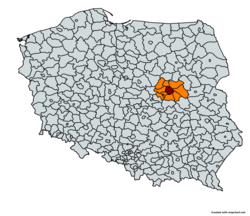world.wikisort.org - Poland
The Warsaw metropolitan area (known in Polish as: Aglomeracja Warszawska) is the metropolitan area of Warsaw, the capital of Poland. The metropolitan area covers ten counties[1] in the Masovian Voivodeship, with an area of 6,100 km²[2] and a population of around 3.5 million in 2022.[3] The area constitutes a separate NUTS 2 unit, as well as a separate police region with a dedicated Capital Metropolitan Police Headquarters, both of them carved out from the Masovian Voivodeship as an exception, as Polish NUTS 2 areas and police regions are in general identical to the territories of voivodeships.
This article uses bare URLs, which are uninformative and vulnerable to link rot. (August 2022) |
This article needs additional citations for verification. (January 2017) |
Warsaw metropolitan area
| |
|---|---|
 | |
 | |
 Map of the Warsaw metropolitan area | |
| Country | |
| Region | Masovian Voivodeship |
| Largest city | Warsaw |
| Area | |
| • Metro | 6,100 km2 (2,355 sq mi) |
| Population | |
| • Metro | 3,053,104 |
| • Metro density | 500.5/km2 (1,296.4/sq mi) |
| Time zone | UTC+1 (CET) |
| Website | omw |
The largest cities or towns within the metropolitan area are Warsaw, Pruszków, Legionowo, Otwock, Mińsk Mazowiecki, Piaseczno and Wołomin.
Public transport in the metropolitan area is served by the Warsaw Transport Authority (Zarząd Transportu Miejskiego).
Economy
Warsaw metropolitan area Gross metropolitan product(GMP) was around US$105 billion in 2019.[4] By total Nominal GMP Warsaw metropolitan area is in top 200 worldwide.
See also
- Metropolitan areas in Poland
References
- http://www.warsawvoice.pl/view/5475
- "Warsaw". www.goeuro2012.com. Archived from the original on 3 June 2008. Retrieved 12 January 2022.
- "Wielka aglomeracja warszawska - Biznes w INTERIA.PL".
- https://ec.europa.eu/eurostat/documents/2995521/10474907/1-05032020-AP-EN.pdf [bare URL PDF]
External links
- Warsaw development strategy until 2010 (archived)
- http://urbact.eu/fileadmin/subsites/civitas/Mazovia_UR_policies_TS.pdf
Другой контент может иметь иную лицензию. Перед использованием материалов сайта WikiSort.org внимательно изучите правила лицензирования конкретных элементов наполнения сайта.
WikiSort.org - проект по пересортировке и дополнению контента Википедии